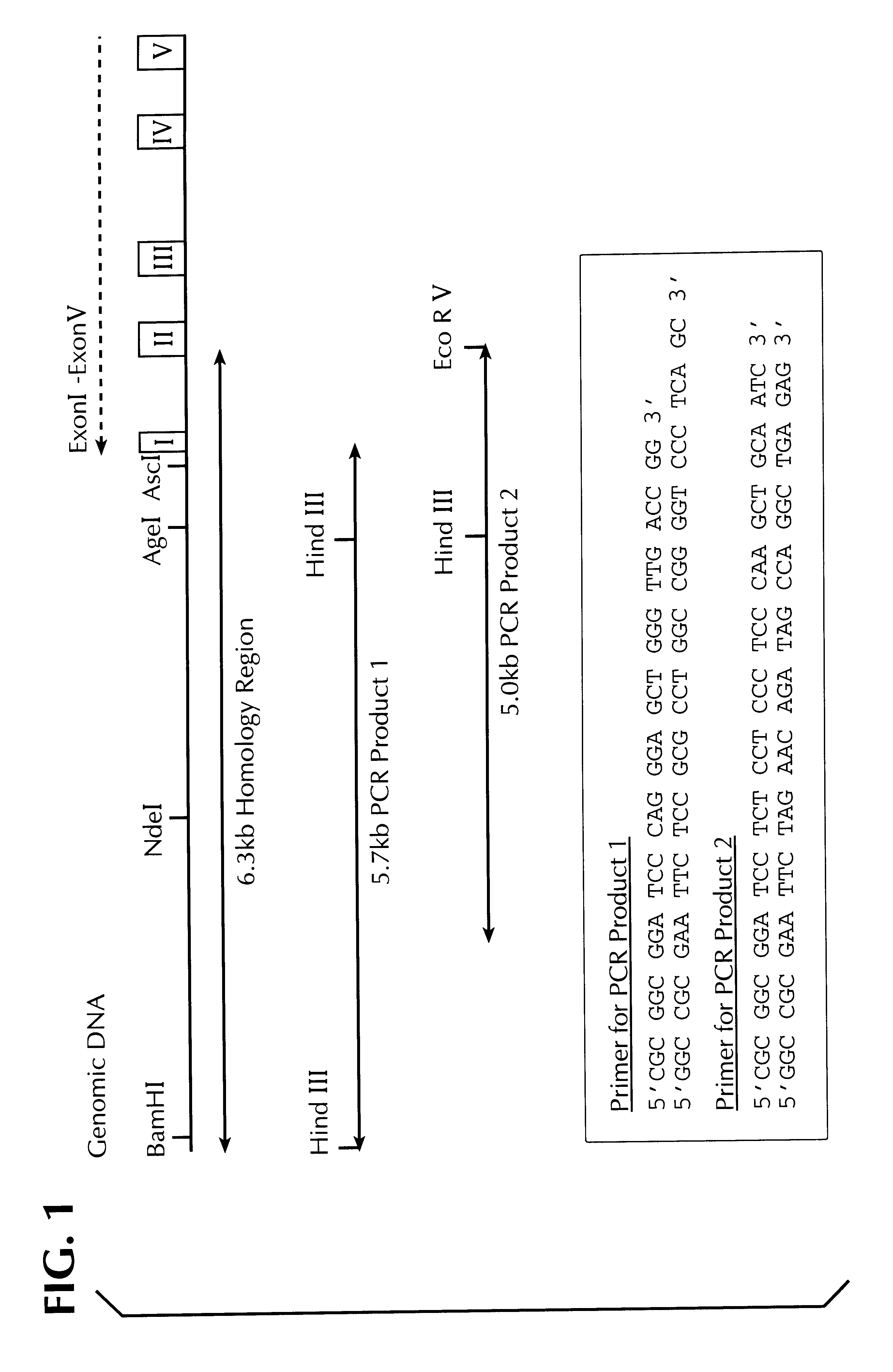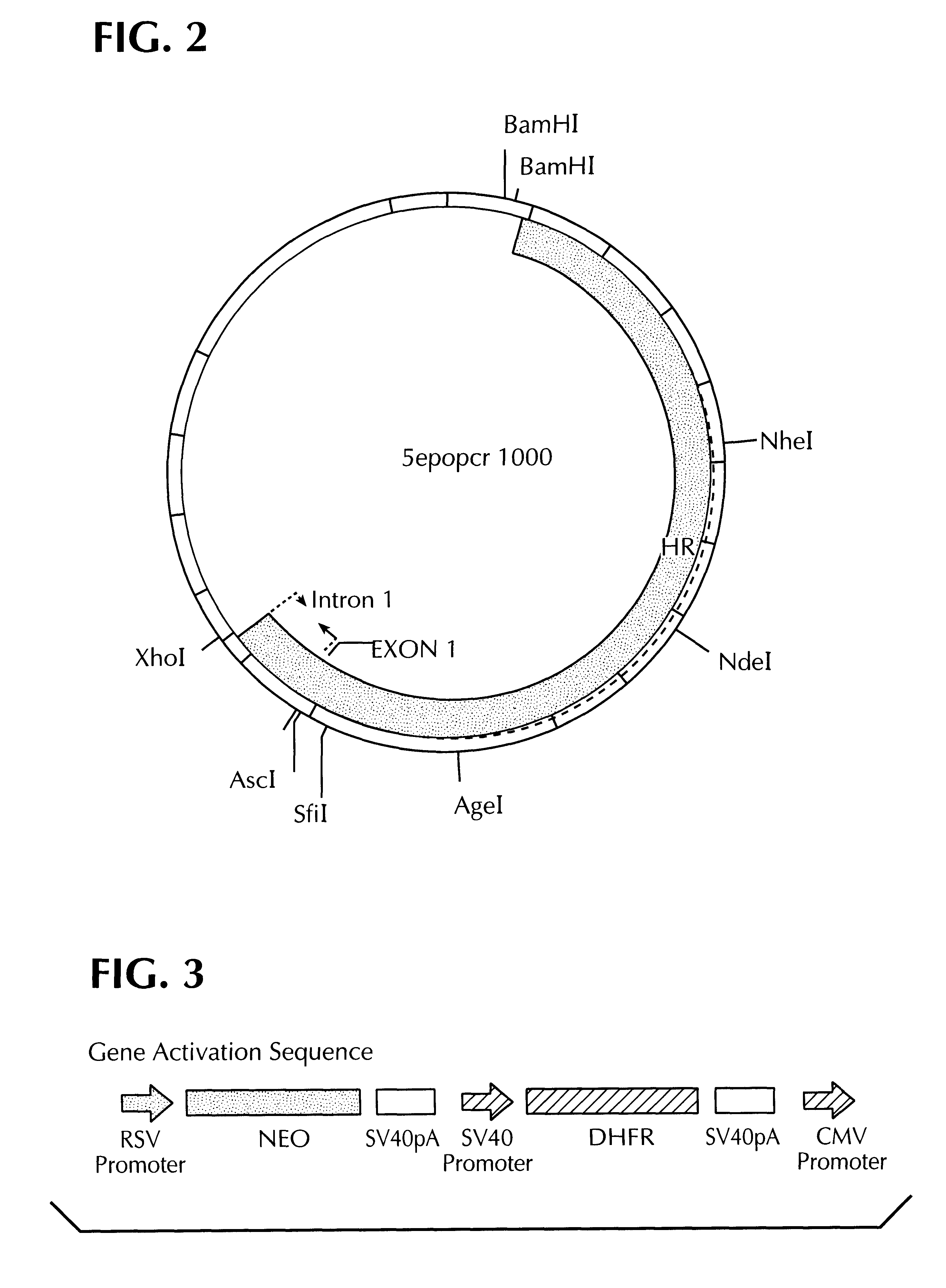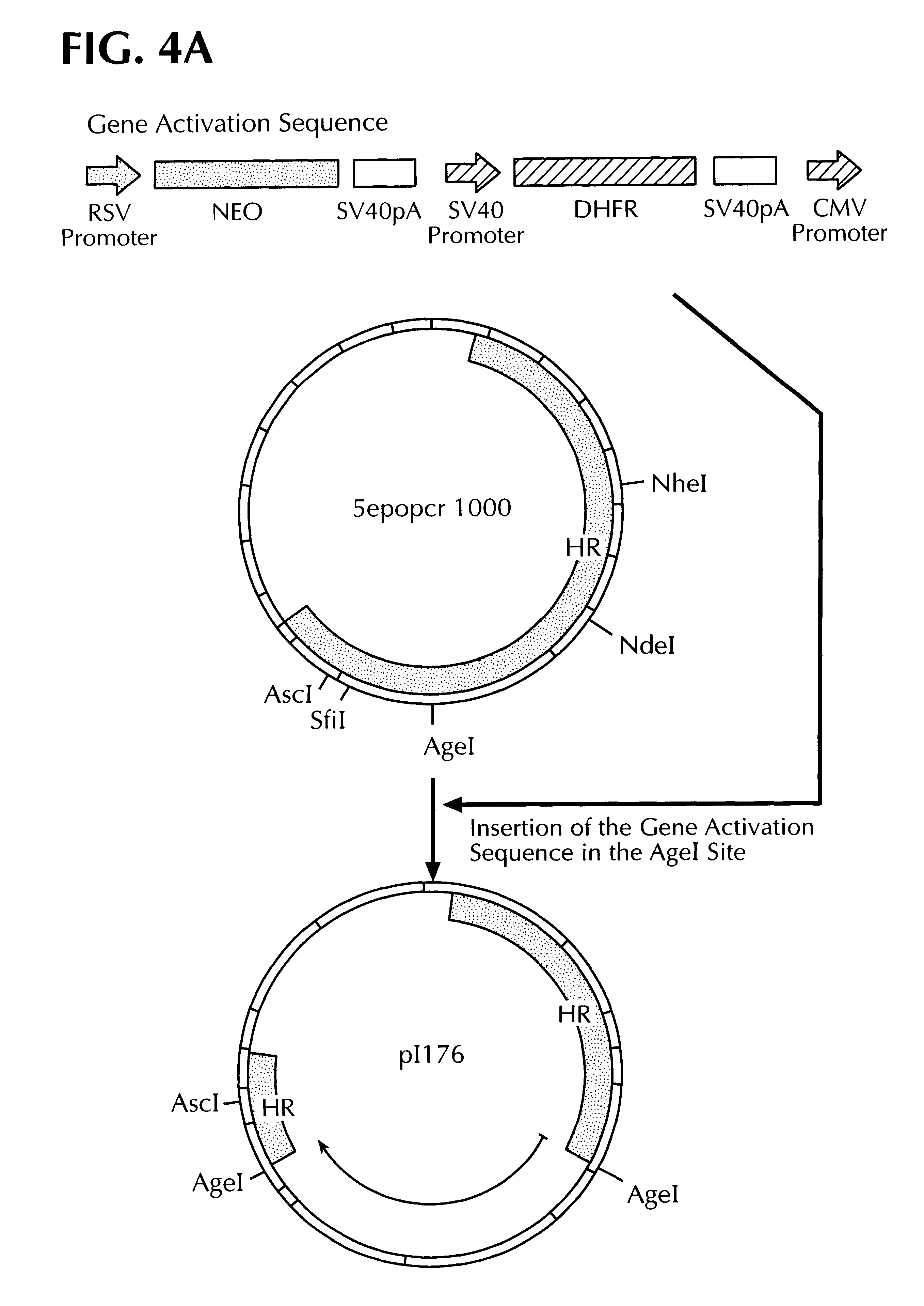Methods for identifying human cell lines useful for endogenous gene activation, isolated human lines identified thereby, and uses thereof
a cell line and endogenous gene technology, applied in the direction of growth factors/regulators, animals/human proteins, animals/human peptides, etc., can solve the problems of inability to ensure high yield and contaminant free production of human protein, and the production yield of cho cells is often relatively limited, and the preparation of large amounts is not easy
- Summary
- Abstract
- Description
- Claims
- Application Information
AI Technical Summary
Problems solved by technology
Method used
Image
Examples
example 2
Cloning of EPO Homology Regions
Homology regions of the EPO gene were amplified by PCR using human placenta genomic DNA. For this, two PCR products were prepared from a 6.3 kB long homology region from the region of the 5'-untranslated sequences of the EPO gene, exon 1 and intron 1 (cf FIG. 1). The primers used to prepare the PCR product 1 had the following sequences: 5'-CGCGGCGGAT CCCAGGGAGC TGGGTTGACC GG-3' (SEQ ID NO: 1) and 5'-GGCCGCGAAT TCTCCGCGCC TGGCCGGGGT CCCTCAGC-3' (SEQ ID NO: 2). The primers used to prepare the PCR product 2 had the following sequences: 5'-CGCGGCGGAT CCTCTCCTCC CTCCCAAGCT GCAATC-3' (SEQ ID NO: 3) and 5'-GGCCGCGAAT TCTAGAACAG ATAGCCAGGC TGAGAG-3' (SEQ ID NO: 4).
The desired segments were cut out of the PCR products 1 and 2 by restriction cleavage (PCR product 1: HindIII, PCR product 2: HindIII and EcoRV) and cloned into the vector pCRII which had been cleaved with HindIII and EcoRV. The recombinant vector obtained in this manner was named 5epopcr1000 (cf. FI...
example 3
Construction of EPO Gene Targeting Vectors
3.1 A gene activation sequence which contains the NEO gene, the DHFR gene and a CMV promoter / enhancer (cf. FIG. 3) was inserted into the AgeI site of the plasmid 5epocr1000 containing the EPO homology region to obtain the plasmid p176(cf. FIG. 4a). In order to bring the CMV promoter as close as possible to the translation start site of the EPO gene, a 963 bp long segment was deleted between the restriction sites AscI and AgeI (partial cleavage) to obtain the plasmid p179 (FIG. 4b).
3.2 In order to optimize expression, nucleotides in exon 1 which code for the beginning of the EPO leader sequence Met-Gly-Val-His were replaced by the synthetic sequence Met-Ser-Ala-His. This sequence was obtained as a template using appropriate primers by amplifying a genomic EPO DNA sequence, e.g., of the plasmid pEPO148 which contains a 3.5 kB BstEII / EcoRI fragment (including exons 1-5) of the human EPO gene sequence under the control of the SV40 promoter (Jaco...
example 4
Transfection of Cells
Various cell lines were selected for the production of EPO and transfected with targeting vectors.
4.1 Namalwa Cells
Namalwa cells were cultured in T150 tissue culture flasks and transfected by electroporation (1.times.10.sup.7 cells / 800 .mu.l electroporation buffer 20 mM Hepes, 138 mM NaCl, 5 mM KCl, 0.7 mM Na.sub.2 HPO.sub.4, 6 mM D-glucose monohydrate pH 7.0, 10 .mu.g linearized DNA, 960 .mu.F, 260 V BioRad gene pulser). After the electroporation the cells were cultured in RPMI 1640, 10% (v / v) fetal calf serum (FCS), 2 mM L-glutamine, 1 mM sodium pyruvate in forty 96-well plates. After two days the cells were cultured for 10 to 20 days in medium containing 1 mg / ml G-418. The supernatant was tested in a solid phase ELISA for the production of EPO as described supra. The EPO producing clones were expanded in 24-well plates and T-25 tissue culture flasks. Aliquots were frozen and the cells were subcloned by FACS (Ventage, Becton Dickinson). The subclones were repe...
PUM
| Property | Measurement | Unit |
|---|---|---|
| Time | aaaaa | aaaaa |
| Mass | aaaaa | aaaaa |
| Time | aaaaa | aaaaa |
Abstract
Description
Claims
Application Information
 Login to View More
Login to View More - R&D
- Intellectual Property
- Life Sciences
- Materials
- Tech Scout
- Unparalleled Data Quality
- Higher Quality Content
- 60% Fewer Hallucinations
Browse by: Latest US Patents, China's latest patents, Technical Efficacy Thesaurus, Application Domain, Technology Topic, Popular Technical Reports.
© 2025 PatSnap. All rights reserved.Legal|Privacy policy|Modern Slavery Act Transparency Statement|Sitemap|About US| Contact US: help@patsnap.com



